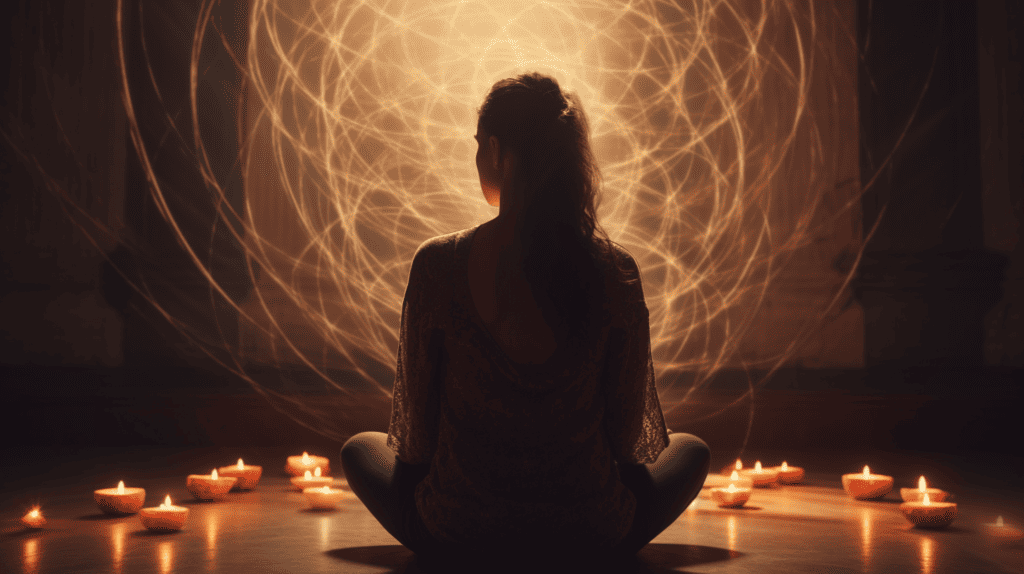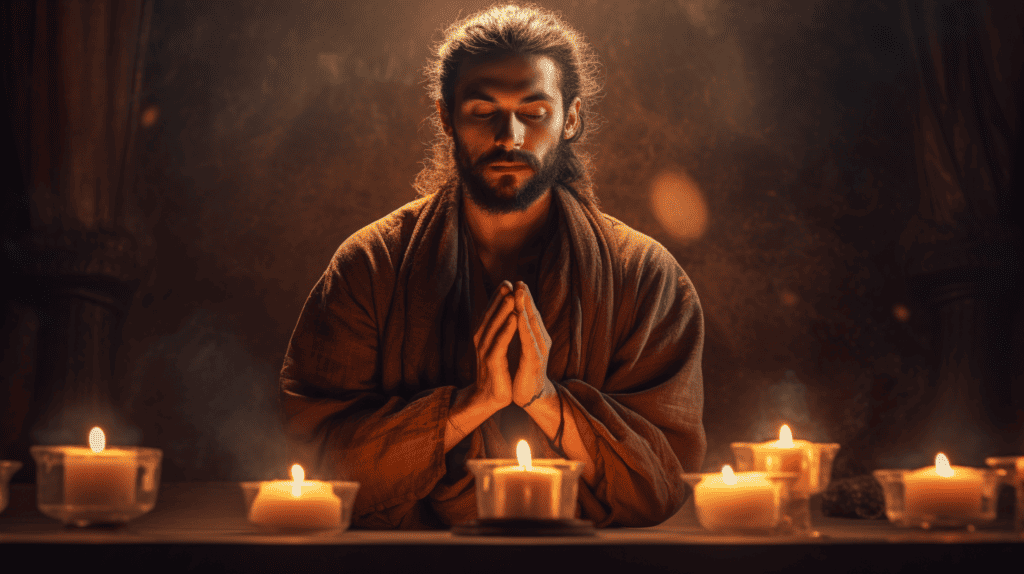Candle gazing meditation, also known as trataka, is an ancient and powerful form of meditation that involves focusing your gaze on the flame of a candle. This centuries-old yogic purification practice is meant to train both the mind and eyes, offering profound spiritual and physical benefits.
In this comprehensive guide, I’ll explain everything you need to know about this transformative meditation technique, from its history to proper techniques, benefits, and safety tips. Read on to learn how to incorporate candle gazing into your own meditation practice for heightened focus, visual acuity, and inner peace.
Key Takeaways:
- Candle gazing meditation (trataka) trains the eyes and mind through concentrated gazing.
- This ancient practice has roots in Hindu, Buddhist, Sufi, and other mystical traditions.
- Trataka improves vision, concentration, stress levels, and more, based on studies.
- It involves gazing at a candle flame and then closing eyes to observe the after-image.
- Start with short sessions of 1-2 minutes of gazing and build up gradually.
- Approach trataka as a calming, centering practice – not an endurance test.
- The candle flame holds symbolic meaning and can ignite inner insight.
- Integrate candle gazing into your meditation routine for added benefits.
A Brief History of Trataka
The practice of trataka likely originated in India thousands of years ago. The term trataka comes from the Sanskrit words Trayate, meaning “to liberate” or “protect,” and trāṭaka, meaning “to gaze.” So trataka essentially means “to gaze in order to liberate”.
This yogic purification practice was first mentioned in the ancient Hatha Yoga Pradipika text, estimated to be over 1,500 years old. The text refers to trataka as one of six cleansing practices meant to purify the body and mind.
Other early mentions of trataka come from ancient Tibetan texts on Buddhist meditation. So, this meditation form has roots in Hindu yogic and Buddhist contemplative traditions.
Over the centuries, trataka spread from India to Tibet, China, and other parts of Asia. This meditation technique continues to be practiced worldwide for its spiritual qualities and health benefits.
What is Candle Gazing Meditation?
Candle gazing meditation, or Trataka, involves fixing one’s gaze on the flame of a lit candle. This unwavering gaze helps train the eyes to stare steadily at a single point without blinking and improves one’s ability to maintain deep concentration.
The basic technique is to sit comfortably with a lit candle placed around eye level, at least three feet away. Keep your spine straight but relaxed. Then, open your eyes and focus your unwavering gaze on the candle flame. Try not to blink or move your eyes. Stare steadily at the flame as thoughts come and go without getting distracted.
Mindful Zen explains that preparing for Trataka meditation can be as simple as sitting quietly for 30 seconds, taking a deep breath, and paying attention to the unique lighting required for this practice.
After a minute or more of steady gazing, close your eyes and visualize the after-image of the flame in your mind’s eye. Try to keep this mental image stable. Then, open your eyes again and repeat the candle-staring process.
This candle gazing and closing the eyes sequence is repeated for 10-15 minutes. The entire trataka session may last up to half an hour. Regular practice improves your ability to hold a steady gaze, and you can gaze longer without blinking. The after-images also become clearer.
TIP: Use a candle made of soy wax or beeswax placed on a stable, fireproof surface. Avoid fragranced candles as the scent can be distracting. The flame should be small, steady, and at eye level. Extinguish the candle properly after your session.
Step-by-Step Guide to Candle Trataka
Here is a simple, step-by-step guide to performing candle-gazing meditation:
- Find a quiet, calm space where you can practice without distractions or being disturbed. Dim the lights in the room.
- Place a lit trataka candle approximately 3 feet away on a stable, raised surface like a table. The candle should be at around eye level when you are sitting. Use an unscented candle, ideally made of natural beeswax or soy.
- Sit comfortably with your spine straight, cross-legged on a cushion on the floor or a chair. Relax your body, but keep your back straight. Hands can rest on the knees in the chin or jnana mudra. Sit facing the candle.
- Close your eyes and take a few deep breaths to relax and clear your mind. Bring awareness to your breath flowing in and out.
- When you feel centered, open your eyes and gaze steadily at the candle’s flame. Your eyes should remain open, fixed on the flame, without blinking or moving. Avoid squinting or straining.
- Keep your eyes still, relaxed, but focused as you observe the details of the flame – its shape, color, flickering movement. Allow peripheral images to blur. Focus only on the small flame.
- Thoughts will arise, but don’t attach to them. Keep bringing your gaze back to the flame. Don’t follow the thoughts or glance elsewhere. Maintain a soft but unwavering gaze.
- Close your eyes gently after 1-2 minutes of steady, unbroken gazing. Observe the after-image of the flame that appears in your mind’s eye, like a translucent imprint.
- Keep this after-image stable and focused as you continue sitting with your eyes closed for 30 seconds to 1 minute.
- Open your eyes again and repeat steps 5-9. Alternate between gazing at the flame and closing your eyes to concentrate on the after-image.
- Complete 5-10 rounds of candle gazing and closing the eyes. End your session by closing your eyes for a few minutes to feel grounded and centered.
- Extinguish the candle properly and safely. Record any observations or sensations from your practice in a journal.
TIP: Avoid overstraining your eyes. Start with short sessions of 5-10 minutes and gradually increase gaze time. Rest your eyes if any discomfort arises.
The Benefits of Candle Trataka Meditation
With regular practice, candle trataka meditation offers profound benefits for both mind and body:
Vision and Eye Health
- Improves eyesight
- Strengthens eye muscles
- Prevents eye diseases like myopia
- Balances nervous system linked to eyes
- Enhances ability to focus at near and far distances
Concentration
- Builds attentional focus and concentration
- Trains the mind to stay fixed on an object
- Counters mind wandering
- Develops mental clarity and one-pointedness
Awareness
- Heightens visual perception and sensory awareness
- Allows detached observation of thoughts
- Creates inner vision for visualization
- Awakens the Ajna or third eye chakra
Relaxation
- Reduces stress
- Calms the mind
- Promotes inner peace and contentment
- Steadies the breath
- Deepens meditation
Regular candle gazing practice also helps increase willpower, improve memory, boost confidence, and relieve headaches or eyestrain from overusing digital devices. Overall, trataka provides a powerful mind-body exercise for cultivating inner spiritual growth.
Candle Gazing vs. Other Forms of Meditation
Candle flame meditation is unique from most traditional forms of meditation:
- Requires keeping the eyes open rather than closed
- It involves gazing rather than just awareness of breath
- Uses an external focal point versus an internal focus
- Visualizes actual images instead of mental ones
Methods like breath awareness, walking meditation, or chanting all allow the eyes to close and the focus to go inward. Candle trataka provides the opposite gaze-based, outward-focused technique.
This yogic practice resembles other open-eyed meditations like Zen Buddhist zazen, Tibetan deity visualization, or the Sufi practice of gazing at the Beloved. However, candle gazing’s emphasis on strengthening eye muscles makes it distinctive.
Trataka is a beneficial complementary practice for meditators looking to enhance their eyesight, attention, or visualization skills. Adding this fiery meditation to your regimen expands and balances your meditative toolkit.
Choosing the Right Candle

While any steady candle flame will do, here are some tips on selecting the ideal trataka candle:
- Small and short-burning – The flame should be just 1-2 inches high to gaze at easily without eye strain. Tea lights work well.
- Made of natural wax – Beeswax or soy wax candles burn cleaner. Avoid paraffin, fragranced, or molded candles.
- With a calm, still flame – Find a candle with good air circulation so the flame doesn’t flicker excessively or blow out easily.
- In a clear color – Natural, uncolored candles are best. Colored candles may impact vision. White, yellow, or gold are ideal.
- On a fireproof surface – Place the candle on a non-flammable coaster on a stable table to prevent fire hazards.
- At eye level when seated – Adjust the candle’s elevated position so you can gaze directly at the flame without straining your neck or eyes.
By selecting the right candle, you’ll maximize the benefits and safety of your trataka practice. Be sure to extinguish the candle carefully after each use.
Altinify recommends closing your eyes to set an intention or breathe gently to relax and develop stillness, then opening them to focus on the three distinct color zones of the candle flame.
TIP: Purchase high-quality beeswax or soy pillar candles designed for meditation. Many come in travel tins for portability.
Precautions and Safety Tips
Always seek professional medical advice if you have any concerns before starting Trataka. While generally safe, it helps to keep these precautions in mind when starting candle gazing meditation:
- Avoid trataka if you have any pre-existing eye conditions or injuries – it may aggravate them.
- Please don’t overdo it at first or force yourself to gaze longer than is comfortable. Start with just 1-2 minutes of candle gazing at a time.
- Stop immediately if you have any eye pain or headaches. Don’t push yourself to keep gazing.
- Have an eye exam before starting if you wear corrective lenses to ensure trataka is appropriate for your vision.
- Never gaze at a candle flame longer than 3-5 minutes at a time without closing your eyes to rest them.
- Keep the candle three feet away to avoid heat or dripping wax injuries.
- Ensure the ceiling above is fireproof and no flammable items are nearby.
- Extinguish the candle carefully after each session and double-check it is entirely out.
With mindful precautions, candle trataka can be practiced safely and enjoyably, even by meditation beginners. Pay attention to your body’s signals, and don’t overdo your gaze time.
TIP: Stay centered and calm during practice. Don’t compete with yourself or force longer gazing. Progress gradually and gently.
How Long Should a Candle Gazing Session Last?
As a general guideline, aim for the following session lengths as you build up your trataka practice:
- Beginners – Start with just 5 minutes total. Gaze at the candle in 1-minute intervals, closing your eyes for 15-30 seconds in between.
- Intermediate – Build up to 10-15 minute sessions. Gaze for 1-2 minutes at a time, with 30-60 seconds, eyes closed in between.
- Advanced – Sessions may last 20-30 minutes total. Gaze at the candle flame unwaveringly for 2-5 minutes before closing your eyes to rest.
Remember, it’s not a competition or test of endurance. Listen to your eyes, and don’t overexert your gaze. With regular practice, your ability to trataka comfortably improves. But always focus on relaxed, mindful gazing rather than the length of time.
TIP: End each candle session with 3-5 minutes of eyes closed to rest your vision and feel grounded.
Tips for Maximizing the Benefits

Here are some additional tips to help deepen your trataka practice:
- Maintain good posture with spine straight but relaxed shoulders. This enhances alertness.
- Gaze with a soft, unfocused gaze instead of straining your eyes. Relax your forehead, eyes, and face.
- Reduce blinking gradually instead of forcing yourself not to blink at all. Blink generally at first.
- Focus on the base of the flame instead of the flickering tip to steady your gaze.
- Don’t worry about how long you can gaze without blinking. Stay relaxed, not competitive.
- Channel the candle’s flame energy to cleanse your mind and purify your thoughts.
- Imagine the light entering your third eye, igniting insight and inner wisdom.
- After closing your eyes, notice any visual phenomena, patterns, or images that arise. Observe without judgment.
- Keep a meditation journal to record your progress and experiences with candle trataka.
TIP: Approach trataka as a soothing, therapeutic practice – not an endurance sport. Prioritize comfort, mindfulness and tranquility.
Common Experiences and Sensations
When first learning candle gazing meditation, you may experience:
- Eyes watering or blinking reflex arising
- Difficulty focusing steadily on the flame
- Mind wandering and distraction
- Impatience or frustration
- Physical discomforts like eye fatigue or dryness
- Visual phenomena when eyes are closed like:
- After-images or colors
- Geometric patterns
- Lightness or darkness
- Floaters or other entoptic phenomena
These reactions are very common, especially for beginners. Don’t get discouraged. With regular, patient practice, your eyes and concentration strengthen. You learn to observe any sensations mindfully without judgment.
Your trataka practice will evolve uniquely as you persist and progress. Over time, you’ll likely notice enhanced control over your vision, deeper tranquility, and sparks of insight.
Integrating Candle Gazing into Your Meditation Routine
Candle trataka serves as either a complete meditation practice in itself or as an ideal warm-up before seated meditation:
- Try replacing your regular meditation session with candle gazing 2-3 times weekly. The visual focus provides a nice change of pace.
- Devote 5-10 minutes to trataka before starting your usual breath awareness or mantra meditation. It preps your concentration and awareness.
- Alternatively, gaze at the candle flame after your regular practice to ease out of meditation.
- On days when you feel restless, trataka can center and soothe your mind before going about your day.
- Some advanced practitioners even do trataka upon waking and before bed to bookend their day mindfully.
With experience, you’ll find how candle gazing fits your routine best. Allow it to enhance, not replace, your seated meditation or yoga practice.
TIP: Practice trataka at the same time daily to integrate it as a habit. But stay flexible based on your energy levels.
Candle Gazing Meditation and the Eyes
Why does staring at a candle flame strengthen eyesight? There are several ophthalmological reasons:
- It improves focusing power – the eye muscles constantly contract and relax to pinpoint the flame’s moving shape.
- Trataka enhances the eye’s ability to adjust to variations in light and distance. This improves blurry vision.
- The practice stimulates nerve transmission and blood circulation to the eyes, nourishing the optic muscles and nerves.
- Gazing without blinking boosts tear production and fluid distribution across the cornea and conjunctiva. This prevents dryness.
Together, these mechanisms reduce eye fatigue, photophobia, and sensitivity to glare or poor lighting. Your vision becomes clearer and more flexible. Regular trataka can even help correct astigmatism and sharpen distance vision.
Mindbodypal recommends having a lit candle at an arm’s length away with the flame at eye level, focusing on a mantra with eyes closed, then opening your eyes to look at the brightest spot of the flame for 10 to 15 seconds before closing them again.
Of course, the benefits also depend on having healthy eyes free of pathology. But in most cases, candle gazing offers real improvements for tired, strained eyes.
The Meaning of the Flame
The candle’s flame holds deep symbolism in many spiritual traditions:
- It represents the light within us – our inner fire, creativity, and wisdom.
- The small, flickering flame depicts stillness through motion-centeredness amidst constant change.
- Its upward, aspirational dance embodies human spiritual growth and evolution.
- The flame transforms wax into light and heat. This symbolizes spiritual purification and transformation.
- Fire burns up the ego, just as meditative awareness dissolves it.
- The flame’s warm glow evokes the heat of tapas (a yogic discipline that burns up impurities).
- The Ajna chakra (third eye) is associated with light and fire energy. The candle activates this chakra.
- The flame’s brightness inspires clarity, insight, and focus.
Contemplate these symbolic meanings to gain a more mystical perspective on the candle’s flame. Let it guide you toward your inner light.
Origins in Yogic and Mystic Traditions
Historically, candle gazing meditation stems from various yogic and mystical traditions:
Hatha Yoga
Trataka is one of the Shatkarma (yogic cleansing) practices outlined in the ancient Hatha Yoga Pradipika text. Along with Neti, Nauli, Kapalabhati, and more, trataka cleans the body in preparation for higher yoga practices.
Tibetan Buddhism
In Tibetan Buddhism, trataka is used to cultivate unwavering meditative focus. The candle’s flame also represents tummo – inner heat energy.
Shambhala Buddhism
The flame symbolizes innate basic goodness and aliveness. Gazing practice is done as a form of mind training and offering.
Sufism
Gazing at a candle in an oil lamp concentrates the mind’s focus away from material illusion and back to Spirit/the Divine.
Taoism
Candle trataka allows the absorption of yang (masculine) fire energy from the flame, balancing inward yin (feminine) energy. This recharges and aligns the Qi flow.
Kundalini Yoga
Trataka ignites ajna chakra energies, bringing inner vitality, intuition, and awareness of the “third eye.”
Qigong
Candle gazing develops internal focus and vision, known as “Yixinggong” (fixing the eyes) in Qigong tradition.
Across traditions, trataka facilitates single-pointed concentration centered around an external flame to fuel inner illumination.
Sample Candle Gazing Meditation Script
Try this guided candle gazing meditation script during your practice:
Begin by lighting a candle and placing it at eye level around three feet before you. Sit comfortably so you can see the flame without straining. Allow your eyes to close and bring full attention to your breath as it flows in and out.
Feel each inhalation spreading coolness and each exhalation releasing warmth. Just breathe naturally without controlling your breath.
When you feel centered in the present moment, gently open your eyes. Begin gazing softly at the candle’s flame. Relax your forehead and eyes. Don’t force your focus. Just observe the flame’s natural dance with a steady yet calm gaze.
Keep your eyes open and fixed on the small, flickering flame. Notice the flame’s changing shapes and colors, but don’t analyze them. If thoughts arise, don’t engage with them. Continuously return the gaze to the flame.
Hold your unwavering yet relaxed gaze upon the candle flame. When you blink, or your eyes want to move, gently guide them back to stare at the flame easily. Avoid squinting or straining.
After 1-2 minutes of relaxed gazing, close your eyes gently but keep them oriented toward where the flame was. Notice the after-image of the flame remains despite your eyes being closed. Try to hold this after-image clearly and steadily in your mind’s eye.
Continue sitting calmly with your eyes closed for about 30 seconds, observing the after-image of the flame in your inner vision. Notice if it changes shape, color, or intensity. Study it with detached awareness.
When ready, you may slowly open your eyes again to gaze upon the external flame. Then repeat this gazing sequence of opening and closing your eyes 5-10 times, for 1-3 minutes each time.
Throughout, remain centered inwardly as you alternatingly observe the candle’s flame externally and then internally. Avoid any strain or force. Find steadiness and ease.
After completing your final eyes-closed visualization, sit with your eyes closed again for another 1-2 minutes. Feel your whole body and breath. Gradually deepen and lengthen each inhale and exhale.
When you feel ready, blink your eyes open slowly. Take your time from meditation, keeping the inner peace and focus. Bow in gratitude to the practice before gently blowing out the candle. Record any observations in your journal.
This simple script helps guide your trataka sequence. But don’t worry about sticking to a precise time or number of rounds. Practice intuitively, focusing on relaxed presence rather than technique. Let the candle flame purify your vision, inside and out.
Research on Health Benefits
Modern research on candle gazing meditation remains limited, but initial studies point to promising benefits:
A study published in the Nepal Journal of Ophthalmology 2016 examined 120 young adult volunteers. Half were instructed to practice candle flame gazing meditation for six months. The other half did not. After six months, the trataka group showed significant improvements in visual acuity and near point of accommodation.
A study in the International Journal of Yoga in 2014 followed 114 volunteers doing trataka training or breath awareness. After 10 days, the trataka group had more significant improvements in eye health, focusing ability, and visual perception than breath meditation.
A Perceptual and Motor Skills 1986 study examined candle gazing’s effects on peripheral vision in 36 volunteers. After 3 months, those doing trataka had expanded their field of peripheral vision compared to control participants.
A study in the Japanese Journal of Psychosomatic Medicine in 2005 reported reduced heart rate variability and lower stress after candle flame gazing meditation versus just rest. This indicates Tataka’s calming effects.
While more research is needed, these initial studies lend credibility to Trataka’s benefits, especially for visual abilities and stress reduction. Together with centuries of tradition, the practice seems well worth exploring.
Final Thoughts on This Meditative Practice
Candle gazing meditation is a unique, powerful form of mind-body training. By training your eyes to stare steadily and one-pointedly at the flame, concentration deepens, vision strengthens, and inner illumination grows.
Approach trataka as a soothing practice – not an endurance competition. Progress gradually and intuitively. Allow the candle’s flame to purify your sight, steady your mind, and transport you to the peaceful present.
Regular practice lets you feel more centered, visually attuned, and equipped to light up your meditation. So brighten up your practice with the fiery glow of candle gazing.
FAQ on Candle Gazing (Trataka)
Q: What are the benefits of candle gazing in meditation practice?
A: Candle gazing or trataka meditation has physical, spiritual, and therapeutic benefits. It helps to improve focus on a small point, in this case, the flame, which can strengthen eyesight and promote mental clarity. It also has spiritual benefits as it can stir up inner energy and manifest it in various forms in one’s life. The therapeutic benefits come from its ability to reduce eye strain and ease anxiety.
Q: How does candle meditation differ from other forms of yoga and meditation?
A: Candle meditation, known as Trataka, involves an unwavering gaze at a small point, usually a candle flame. This helps bring energy to one’s consciousness. Compared to other types of yoga and meditation, it’s more focused on a single external point. Enhancing concentration and mindfulness can help achieve a deeper meditation practice.
Q: How does practicing trataka improve the meditation experience?
A: Practicing trataka or candle gazing supports a deeper meditation practice. It encourages an unwavering focus on a single point: the flame. This exercise of persistently gazing at a flame can help to create a deep sense of calmness and manage stress, enhancing the overall meditation experience.
Q: Can anyone practice candle gazing?
A: Yes, anyone can practice candle gazing. All it requires is a non-toxic candle and a comfortable position to sit in so that you can focus steadily on the flame. The practice encourages a more profound and more mindful meditation experience.
Q: What are the spiritual benefits of candle gazing?
A: The spiritual benefits of candle gazing or trataka can be profound. The practice can inspire self-exploration and insights, bringing latent energies to life. It can also foster mindfulness, which can bring a deeper sense of purpose and a greater understanding of one’s own spiritual path.
Q: Can candle gazing yoga help improve the quality of my vision?
A: Indeed, one of the benefits of candle gazing is that it can improve your vision. Constantly focusing the eyes on candlelight strengthens eye muscles and improves their function. However, be aware that positive results generally take time and consistent practice.
Q: Could you explain how to begin with the practice of trataka?
A: To begin with trataka, first ensure you’re in a comfortable position, in a low-light room. Place a non-toxic candle at eye level, about 2-3 feet away. Keep your gaze steady on the flame, without blinking, for as long as comfortable. Over time, try to increase the length of the gaze. Eventually, you may close your eyes and visualize the flame.
Q: What does “to gaze” mean in relation to trataka?
A: In the context of trataka, “to gaze” refers to focusing your gaze on a small point, namely the flame of a candle, without interruption or blinking. This practice aims at enhancing concentration and providing a tranquil state of mind.
Q: Is candle gazing beneficial for mental health?
A: Yes, candle gazing mediates its therapeutic benefits by bringing a certain calmness and clarity to the mind. The steady gaze on the flame helps in controlling the flow of thoughts which provides relief from stress, anxiety, and depression.
Q: What are some of the physical benefits offered by the practice of candle gazing?
A: Some of the physical benefits offered by the practice of candle gazing include strengthened eye muscles and improved eyesight as you focus your gaze on a small point. It can also contribute to an improved sense of balance and coordination by helping to focus mental energy. Additionally, regular practice can stimulate the pituitary and pineal glands, which benefit overall physical health.





Leave a Reply